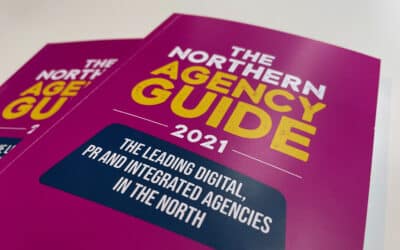The impact of the last year and a half has opened up opportunities for non-London agencies, but it’s also changed what it means to run a great pitch.
Charlotte Boerescu-Kelly, Head of Marketing at the GO! Network – the only marketing intermediary outside of London – talks about how agencies can make the most of these changing requirements.
GO! are a co-headline sponsor of this year’s Northern Agency Guide, which was launched today – order your copy here.
We’ve seen a few trends come and go over the last 18 months – some obvious, some not so much.
What specialisms are in the highest demand?
Way back in early 2020, after an initial burst in digital advertising as budgets were reshuffled and allocated, brands across sectors took advantage of the relative downtime, and started looking inwards.
Rather than lead generation, brands began to look inside themselves, adapting even the very core elements of their offering. Later on in the ‘unprecedented’ year, we saw an influx in brands looking for research-led deep dives into customer offerings and brand perception.
For many incumbent brands, this has been more than making the most of their spare time – there’s been a reset that’s pushed them to action. Having to move into almost entirely digital marketing has levelled the playing field in terms of ‘who reaches who’, so a savvy digital strategy essentially allows any brand to outperform competition, regardless of who’s previously had a monopoly on the market share.
Branding, strategy, market research, everything that tells you who you are as a business – all of these types of brief are continuing to go strong from what we’re seeing – but there are two more unlikely heroes.
Incoming briefs looking for support on traditional PR and employee engagement strategies are both on the rise as we speak. Our recent survey showed employee retention to be the most common business challenge for brands, above customer retention or even resource.
It’s not a surprise; employee culture and engagement are more important to staff than ever before – for many, it’s been their only grounding during the last year – and we’re seeing an influx of brands investing in internal communications and branding because of it.
Similarly, after an oversaturation of digital and lead generation, many brands – particularly across retail and other consumer-focused sectors – are looking for somewhere with a little more breathing space, turning to traditional PR strategies to build their reputation and awareness.
Opening up opportunities for independent and non-London agencies
Where location used to be a non-negotiable requirement for many, office and headquarter locations have become ‘nice to haves’. With many brands relocating or adjusting to working remotely, we’re starting to see brands get more flexible with location.
A nice side effect of this is that brands are getting a little braver with exploring options outside of the London bubble – and often, they’re pleasantly surprised by what they find. If this trend continues, I’m even optimistic that we can put away the phrase ‘regional agency’ for good.
There’s also an opportunity to be found for smaller agencies, provided they can make it to the pitch. As the landscape grows more competitive in areas like financial services and B2B, businesses with larger budgets are looking to feel like they’re bringing something unique to the table, but also like they’re the top priority for their partner.
The uncertainty of the past year has resulted in a need for total flexibility and the ability to adapt to the needs of the brand – marketing strategies changing at short notice and constant re-evaluating of strategy to justify investment mean that agencies need to be available more frequently, but also more capable of rolling with the punches. If an agency can demonstrate their ability to act reactively and bring in different specialisms where needed, it’s setting them in good stead for longer term projects.
What’s winning the brief?
One of the most common questions we get as an agency search network is what gives agencies the edge. It’s worth noting that any agency we endorse to a brand has to fulfil certain criteria as a given, including relevant experience, case studies, matching budget expectations, and so on.
When this is the case, it’s ultimately about the chemistry and the passion for the brand. Where in the past, agencies would be criticised for ‘fluff’ and not focusing on hard results, in-house marketing leaders are looking for agencies that fit their needs culturally.
With a virtual pitch, you don’t get any chance for small talk beforehand, or to go and grab a coffee afterwards. Make sure you tick the boxes in your pitch, but let your personality come through. Part of what we do is ‘chemistry calls’ – exactly what they say on the tin, giving brands and agencies a chance to catch up and talk more casually so we can start exploring that cultural fit.
Much like a job interview, it’s about finding out if you’re both a good fit for each other. We’ve seen many agencies succeed regularly because the brand feels comfortable with them – similarly, we’ve seen plenty of perfectly capable agencies lose out because they seemed uninterested, or “didn’t click”.
Lastly, this might not sound like rocket science but it’s absolutely crucial to demonstrate that you care about the brand.
Do your homework, follow up with the brand after the call to show your own interest in the business, mention recent news that they’ll care about. In a year that’s left many feeling isolated, demonstrate that you’re a person who wants to connect on more than just a transactional level.
In short, the market might feel saturated right now, but there are plenty of opportunities to come. As a Manchester-headquartered business, it’s exciting to see more and more agencies in the North get recognition, and there’s no reason for the ball to stop rolling.











